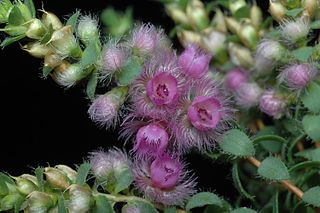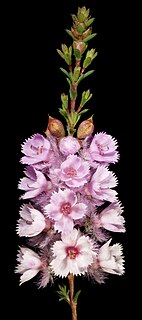Verticordia attenuata is a flowering plant in the myrtle family, Myrtaceae and is endemic to the south-west of Western Australia. It is a shrub with a single main stem, small leaves and pink to purple flowers which fade to white as they age. It usually grows in sand in areas that are wet in winter, often amongst grasses and is found in coastal areas near Bunbury.
Verticordia auriculata is a flowering plant in the myrtle family, Myrtaceae and is endemic to the south-west of Western Australia. It is a small, multi-branched shrub with small leaves and spikes of pink to magenta-coloured flowers in late spring to early summer and it is widespread in the wheatbelt.

Verticordia blepharophylla is a flowering plant in the myrtle family, Myrtaceae and is endemic to the south-west of Western Australia. It is an erect, open shrub with a single main stem, leaves with hairy margins and pale to deep mauve-pink flowers and which occurs in an area between Perth and Geraldton.
Verticordia bifimbriata is a flowering plant in the myrtle family, Myrtaceae and is endemic to the south-west of Western Australia. It is an open shrub with small leaves and spikes of pink flowers.
Verticordia sect. Pennuligera is one of six sections in the subgenus Eperephes. It includes sixteen shrub species in the genus Verticordia. Plants in this section range from small and spreading to large shrubs and have been referred to as "lettuce-leaved" or "round-leaved". The flowers are relatively large, with their sepals having feathered lobes and ear-like appendages on a stalk so that the appendages cover the floral cup. The petals are oval to egg-shaped or round and are usually fringed.

Verticordia pennigera, commonly known as native tea, is a flowering plant in the myrtle family, Myrtaceae, and is endemic to the south-west of Western Australia. It is usually a small erect or prostrate shrub with small leaves and lightly-scented spikes of pale pink to magenta-coloured flowers in spring.

Verticordia halophila, commonly known as salt-loving featherflower, or salt-loving verticordia, is a flowering plant in the myrtle family, Myrtaceae and is endemic to the south-west of Western Australia. It is an erect, bushy shrub with small, crowded, thick leaves and spikes of red and pink flowers in spring.
Verticordia sect. Tropica is one of six sections in the subgenus Eperephes. It includes three species of plants in the genus Verticordia. Plants in this section occur are the only verticordias to occur in tropical areas of Western Australia and the Northern Territory, including the Kimberley and Kakadu National Park and they have the ability to regrow from a lignotuber after fire. They have leaves which vary in size from tiny and pressed against the stem to long and curved but are always linear in shape. The flowers have fringed petals and lobed sepals with small, ear-like appendages and the style has a narrow band of hairs near its tip.
Verticordia centipeda is a flowering plant in the myrtle family, Myrtaceae and is endemic to the south-west of Western Australia. It is a shrub with a single stem at the base, small crowded leaves and greenish-pink flowers with a silvery fringe, in spike-like groups on the ends of the branches. It is common in areas around Geraldton.

Verticordia chrysostachys is a flowering plant in the myrtle family, Myrtaceae and is endemic to the south-west of Western Australia. It is an open-branched shrub with egg-shaped to almost circular leaves, and spike-like groups of cream-coloured or deep yellow flowers.

Verticordia lindleyi is a flowering plant in the myrtle family, Myrtaceae and is endemic to the south-west of Western Australia. It is sometimes an openly branched shrub, other times more or less dense, with small leaves and spreading, spike-like groups of pink or purple flowers along the stems in summer, sometimes also in autumn.
Verticordia luteola is a flowering plant in the myrtle family Myrtaceae, and is endemic to the south-west of Western Australia. It is a more or less openly branched shrub with crowded leaves on its side branches and spikes of pale yellow or bright pink flowers which turn cream to brownish as they age. This verticordia is a summer-flowering species.
Verticordia mitodes is a flowering plant in the myrtle family, Myrtaceae and is endemic to the south-west of Western Australia. It is a shrub with a single, highly-branched main stem, small leaves and small spikes of magenta-coloured flowers in late spring.
Verticordia paludosa is a flowering plant in the myrtle family, Myrtaceae and is endemic to the south-west of Western Australia. It is an openly branched shrub with small leaves and pink to magenta flowers with spreading, feathery sepals and erect, fringed petals in summer and autumn.
Verticordia pholidophylla is a flowering plant in the myrtle family, Myrtaceae and is endemic to the south-west of Western Australia. It is a shrub with a single branch at the base and many side branches with overlapping yellowish leaves and greenish-white to cream, cup-shaped, feathery flowers.

Verticordia tumida, commonly known as summer featherflower, is a flowering plant in the myrtle family, Myrtaceae and is endemic to the north-west of Western Australia. It is an open shrub with very small leaves and clusters of deep pink flowers from late spring to early winter.
Verticordia wonganensis is a flowering plant in the myrtle family, Myrtaceae and is endemic to the south-west of Western Australia. It is a shrub which grows near Wongan Hills and has a single main stem, small leaves and spike-like groups of large, pink, feathery flowers.
Verticordia sect. Pilocosta is one of eleven sections in the subgenus Verticordia. It includes three species of plants in the genus Verticordia. Plants in this section are mostly small, bushy shrubs greyish, needle-like leaves and hairy, rather than feathery flowers. Plants in this section have a flower cup with 10 hairy ribs, fringed sepals and a style which is hairy and has a distinct cap. When Alex George reviewed the genus in 1991 he formally described this section, publishing the description in the journal Nuytsia. The name Pilocosta is from the Latin words pilus meaning "hair" and costa meaning "rib" referring to the hairy ribs on the floral cup.
Verticordia sect. Catocalypta is one of eleven sections in the subgenus Verticordia. It includes seven species of plants in the genus Verticordia. Plants in this section are small, bushy shrubs which grow to a height of up to 1 m (3 ft), have thick, fleshy, leaves which are triangular in cross-section. The flowers are arranged in open, corymb-like heads of relatively large flowers. Importantly, their sepals have down-turned, tufts of hair which surround the floral cup.
Verticordia elizabethiae, named as Elizabeth's featherflower, is a flowering plant in the myrtle family, Myrtaceae. An endemic species of Southwest Australia, it occurs near salt lakes as an erect bushy shrub.






